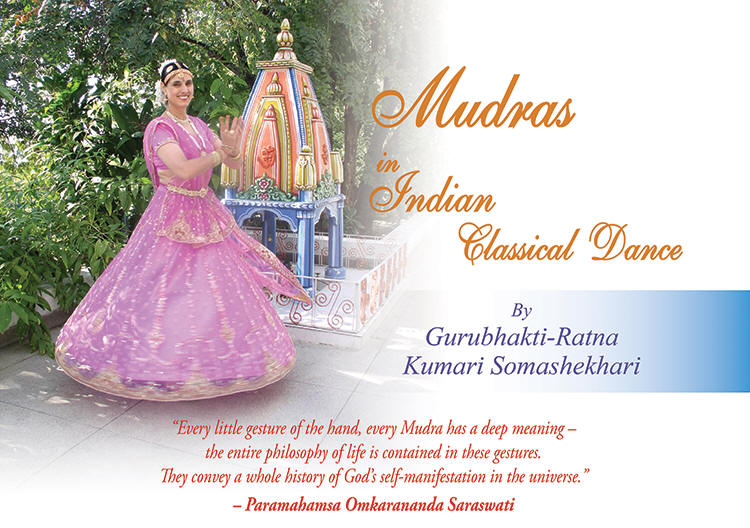
Definition
of "Mudra"
The Vedic
Hymns, Mantras and Mystical Syllables are the Life- and
Light-giving Forces of the Vedic Culture. The recitation of the
Hymns, Mantras and Mystical Syllables are sometimes accompanied by
hand gestures and hand movements. These hand gestures are called
"Mudras".
Some people are
of the opinion that the word "Mudra" is denoting a
"seal", meaning
hereby, that the hand gesture places a seal or puts a finishing
touch to the Mantra, with which it is linked.
Others say that
it comes from the Sanskrit word "Mud", meaning "Joy"
or "Bliss".
This Bliss is attained through the divine powers of the Mudras or
hand gestures, which emphasize and intensify the concentration on
the Divine and attract the Blessings of the Divine.
Sri Vidya
Upasakas know, that certain sacred hand gestures or Mudras are a
Source of Joy not only for themselves, but also for the Divinities
worshipped.
The Mudras,
performed along with the Mantras or Mystical Syllables, combine
elegance with Mysticism. They purify, energize and divinize the
spiritual aspirant in a similar way as the recitation of Mantras.
Mudras in Indian Classical Dance
Mudras play a
very important role in the Indian Classical Dance.
There are
single hand gestures, called "Asamyukta Hastaah" (hands, not
united), which can be executed either by the right hand only, or
the left hand only, or by both hands simultaneously (without
combining the two hands).
There are also gestures, which are
formed by uniting both the hands, they are called "Samyukta
Hastaah" (united or combined hands).
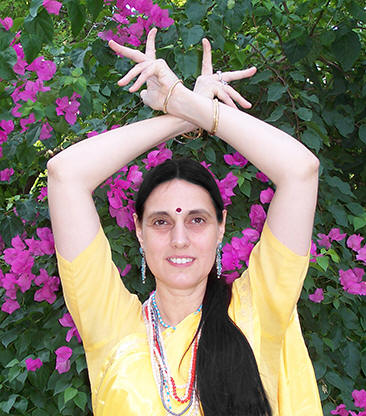 |
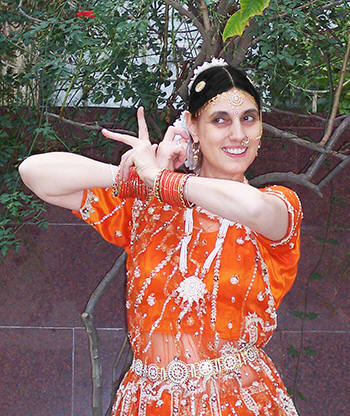 |
Two "Alapadma"
- hands crossed above the head
depict the sun or
the abode of Gods. |
Soma showing the
parrot. This holy bird
symbolizes the Divine Wisdom of
the Vedas. |
According to the ancient
scripture "Abhinaya Darpana" (Nandikeshwara) there are 28 single
hand gestures and 24 united hand gestures. All these different
hand gestures or Mudras are frequently used in Indian Classical
Dance forms, specially in Bharatanatyam. There are even special
hand gestures or Mudras which denote all the Gods and Goddesses
(Brahma, Vishnu, Shiva, Saraswati, Lakshmi, etc.), the four
different castes (Brahmana, Kshatriya, etc.), different relations
(mother, daughter, etc.), the nine planets (sun, moon, etc.),
rivers (Ganga, Yamuna, etc.), animals (lion, deer, etc.) and so
many things more.
Any sincere student of Indian Classical Dance
has to learn by heart all the 28 single and 24 combined Mudras.
Each of these Mudras has a Sanskrit name. When a student is
showing the Mudras, he or she also has to recite the corresponding
Sanskrit names along with them. It is like learning an audiovisual
alphabet or a language. Since the Mudras can convey myriads of
meanings, the "Viniyoga" (Usage) of each Mudra should be
practised, so that one gets the knowledge of how Mudras are used
in different contexts and thereby acquire different meanings. When
a dance student has learned and understood all the different
Mudras and the many meanings, which they can express, he or she
can immediately make out the meaning of any performance of Indian
Classical Dance, without having been told in detail, which story
the dance unfolds.
Children,
learning Indian Classical Dance and Mudras during their
summer holidays in Omkarananda Ashram Himalayas
from
Kumari Somashekhari. From left to right: Neha (from
Omkarananda Nagar, Muni-ki-Reti, Rishikesh),
Prachi
(from Lucknow), Pinky (from Omkarananda Nagar,
Muni-ki-Reti, Rishikesh) and Samyukta (from Chennai). |
 |
Here the children demonstrate the
Mudra "Ardhachandra", which means
"Half-Moon". If the fingers of the right hand
in
"Ardhachandra" are pointing upwards, this
Mudra is also called "Abhaya Hasta", the
fear-removing, blessing and
protecting hand gesture,
and if the fingers of the left hand of the same Mudra are
pointing downwards, it is called "Varadaa",
the hand gesture of granting boons, material and spiritual
wealth. Often Parvati Devi is depicted with these two hand
gestures. |
Here is a short example of how Mudras in
Indian Classical Dance can be used:
The first hand gesture in
the alphabet of the Mudras is "Pataaka", which means literally
"Flag". It is called "Flag", because it actually looks like that
and so it is easy for the students to remember and make that Mudra
if the teacher orders them to show "Pataaka". In the Mudra
"Pataaka" all fingers are straight and extended and close
together. Only the thumb is slightly bent towards the base of the
index finger. By moving the right hand or the left hand or both
hands simultaneously in the "Pataaka" Mudra, many different
meanings can be expressed in the dance, like: "the beginning of
dance", "clouds", "forest", "night", "river", "wind", "entering a
street", "waves", "opening the door", "taking an oath", "to bless
somebody", and many other things. With only one single hand
gesture a dancer can convey so many things!
There is another
Mudra from the Mudra alphabet which I want to mention here,
"Suchi". "Suchi" means literally "Needle". This Mudra exactly
looks like a needle. The index finger is extended and straight and
all the other fingers, including the thumb, are bent towards the
palm. Many things can be shown with the "Suchi" Mudra:
"searching
something", "to contemplate", "scolding somebody", "making a hair
braid", "playing a temple drum", etc. Even highly mystical or
metaphysical things can be expressed with this simple "Suchi"
Mudra, for example, when one or both hands in this Mudra are held
a bit over the head level and the wrists execute soft, circular
movements, the creating or sustaining Divine Power of the wondrous
universes, the galaxies, is depicted.
When the right hand in
the "Suchi" Mudra is held in front of the chest (in front of the
"spiritual heart" ) and moved slowly up above the head level, this
Mudra indicates "Paramashiva" or "Parabrahma", the Undivided, the
One without a second, the Absolute.
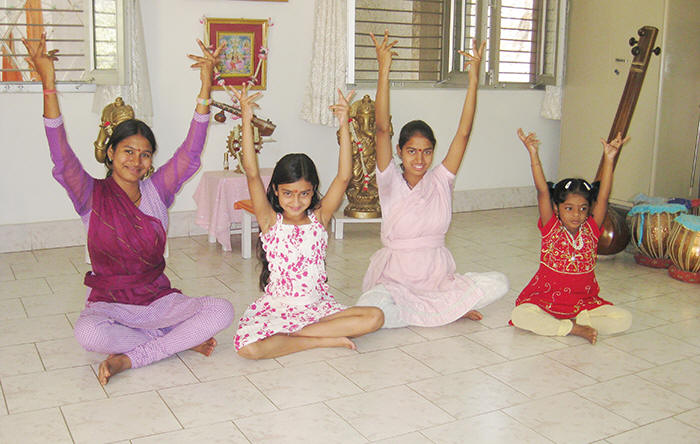 |
Showing "Alapadma", the fully blooming Lotus,
with both hands,
and arms stretched upwards, can
depict "the sky", "happiness", etc. |
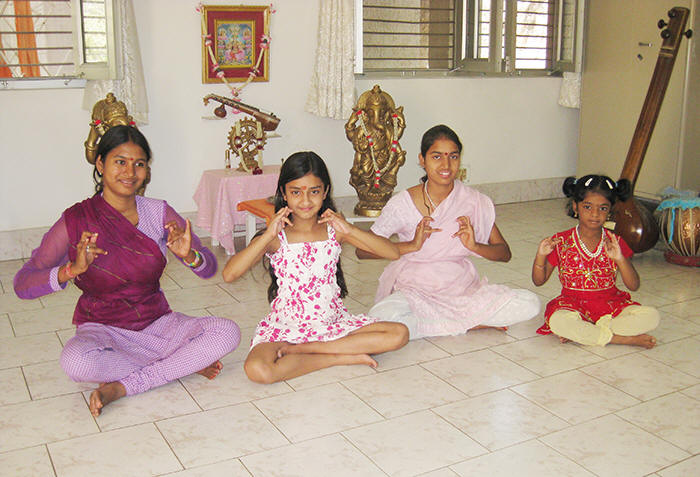 |
| The children practise a
variety of "Katakaamukha", a Mudra, which is
often used to depict Lakshmi or Parvati Devi. |
The Creative and
Educational Aspect of Mudras
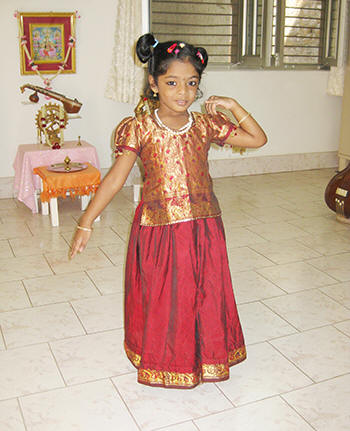 |
Samyukta from Chennai
learns the graceful style of walking from Kumari
Somashekhari, using "Dola Hasta" with the
right hand and "Mrgashirsha" or
"Chatura Hasta"
on the left shoulder. |
Children as well as adults enjoy
the multitude of things, which can be shown by using the Mudras.
With a few changes of finger positions a flying bird can be shown
or a swimming fish, a dancing peacock, a honeybee hovering over a
flower, the tender waves of a calm river or the ferocious waves of
the ocean, clouds, the sun, the rain, lightning, the beauty of the
moon, the tenderness, grace and beauty of women, playing of
various music instruments, and so many things more.
If dancers
have thorough knowledge of Mudras and sufficient experience, how
to apply them in dance, they can choreograph easily new dances to
Bhajans, Vandanas or any subject of their choice and they can
understand to a great extent Indian Classical Dance items of other
artists, even if they see them for the first time.
The Healing
Powers of Mudras
Mudras have definitely healing powers. By
stretching or bending the fingers or exerting pressure on
fingertips or palms, unbalanced energies in body and mind, causing
diseases, can be balanced, tensions can be released. By practising
Mudras properly, blocked energy can be released and flow freely.
Hereby accumulated toxins are removed and the bodily system is
purified and harmonized.
The Mystical Aspect of Mudras
From
the statues and pictures of the Gods and Goddesses we can see that
Their hands are all formed in beautiful definite Mudras. The hand
expressions of the Divinities are never casual or in an ordinary
human way. One can take the example of any Divinity, be it Lord
Shiva or Ganeshji or Lakshmiji or Parvati Devi, etc.
Mudras
play a most important role in Sri Vidya, the worship of the
Supreme Divine Mother, Shri Lalita Mahatripurasundari, the Goddess
of Infinite Love, Infinite Purity, Infinite Beauty, Power,
Sweetness and Tenderness. When the Goddess is worshipped and
invoked through special Bija Mantras, corresponding hand gestures
have to be performed. These sacred Mudras multiply the effects of
the Bija Mantras. The combination of Mantra recitation and
simultaneous performance of the corresponding Mudras helps the
sincere and pure-hearted devotees to progress very fast on the
spiritual path till the aim, the spiritual union with one's
Ishta-Devata, is reached. The Bija Mantras and their corresponding
Mudras are secret and can be learned only after special
initiations. The conditions for learning these Mantras and Mudras
are utmost outer and inner purity, otherwise the sacred Mantras
and Mudras will have an adverse effect. If they are practised with
low, selfish, sensual and passionate motives, they will lead fast
to one's destruction.
Often we get glimpses of the mystical
aspect of the Mudras in the Indian Classical Dance, too, specially
where the different Gods and Goddesses are depicted, but also in
the purely rhythmic, so-called abstract portions of the Indian
Classical Dance. Here the emphasis is on powerful foot-work and
graceful body-movements. No special story is told, but Mudras are
used to beautify the rhythmic and graceful movements in this
abstract form of dance.
 |
From
left to right: Neha in the pose of Lakshmi Devi,
Somashekhari
in the pose of Parvati Devi and Pinky in
the pose of Saraswati Devi |
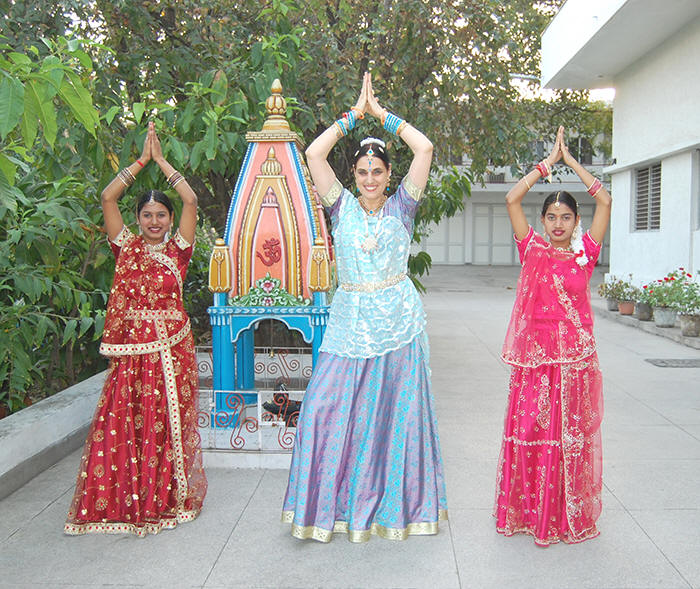 |
| Soma
and her students Neha and Pinky with the "Anjali
Mudra" through which the Divine is worshipped
and glorified |
Usually dance experts are of the
opinion that in the pure rhythmic portion of Indian Classical
Dance (like in Jathiswaram, Tillana, etc.) Mudras do not convey
any special meaning, but have just decorative purpose. I do not
fully agree with this view. Of course, Mudras in the rhythmic part
of dance have definitely an aesthetic charm and appeal, but they
also exert subtle energies on the physical as well as the
spiritual level. Here a strong parallel can be observed between
the role of the Mudras in the Sri Vidya worship and in the Indian
Classical Dance, which is also a form of worship.
In ancient
times, Temple Dancers used to dance in front of the Deities to the
recitation of Bija Mantras. Unfortunately, the practice of these
sacred dances has come out of vogue. The Mudras, which the dancers
have performed along with the Bija Mantras, may have resembled the
sacred Mudras, which are used for example in the Sri Vidya
Upasana.
 |
| Pinky with the
"Kapittha Mudra", depicting Lord Ganesha |
Sometimes glimpses of these Mudras can still be seen
in the so-called abstract or rhythmic portions of Bharatanatyam
Dance. I want to give one practical example for this:
When the
finger tip of the index finger of the "Suchi" Mudra is slightly
bent a Mudra, called "Ankusha", is derived. This Mudra is not
specially mentioned in the Dance-Mudra-Alphabet, though it
resembles the "Taamrachuda" Mudra. "Ankusha" Mudra has a great
importance in the rhythmic, non-story telling dance part. "Ankusha"
Mudra is a mystical Mudra, used specially by Sri Vidya
Upasakas, since the most beautiful, enchanting Goddess, Shri
Lalita Mahatripurasundari, is holding one "Ankush" (goad) in Her
right hand. It is an important Mudra, which attracts material and
spiritual success and influence. In the rhythmic portions of
Bharatanatyam Dance sometimes this Mudra is used at the shoulder,
near the face. It looks really attractive and charming.
I want
to throw light upon another practical example for the mystical or
metaphysical aspect of Mudras in the rhythmic "abstract" portions
of Indian Classical Dance, this time from the North-Indian Temple
Dance, Kathak. Very often a special Mudra is used in the Kathak
Dance, which is called "Kamal ghumaanaa", which is Hindi and
literally means "to turn around the Lotus".
For this one has to
make "Araala Mudra" with both hands, combine the wrists of both
hands in front of the chest (in front of the spiritual heart) and
turn them around continuously in a soft manner. The Heart Lotus,
situated on a very subtle level, is not static, but consists of
brilliant, moving light waves, sound and fragrance, and can be
shown on the material level with the Kathak Dance Mudra "Kamal
ghumaanaa".
I feel, that in the so-called abstract, purely
rhythmic part of the Indian Classical Dances, the Mudras, used
along with the rhythmic steps and the graceful poses, execute and
transmit a certain spiritual power.
Though these Mudras don't
convey a specific story in this context, they radiate an
irresistible charm and a dignified, divine beauty. Here, in this
context, we may compare the abstract, non-story telling Mudras
with the Bija Mantras, which can not be easily translated into
human words or human conceptions, but still are real and are fully
charged with divine powers.
 |
| Gurubhakti-Ratna Kumari
Somashekhari performing dance during Omkarananda Mahotsava
Celebrations. |
Many facts about the metaphysical
meanings of the Mudras in the Indian Classical Dance have been
forgotten over the centuries. The dancers are often taught these
Mudras along with the movements and rhythmic steps without
learning the deeper meanings behind them. They execute the
beautiful Mudras along with the dance movements just for the
beauty sake. But some of the dancers may be intuitively aware,
even if they are not specially taught about it, that certain
Mudras or dance gestures generate a considerable divine, subtle
power or energy, besides looking elegant and beautiful. This is
what makes our Indian Classical Dance so special and
differentiates it from other dances in the world.
The Mantras
and Vedic Hymns are the language of the Gods and the Mudras are
the hand gestures of the Gods. OM.
The Hamsaasya or Chin-Mudra
 |
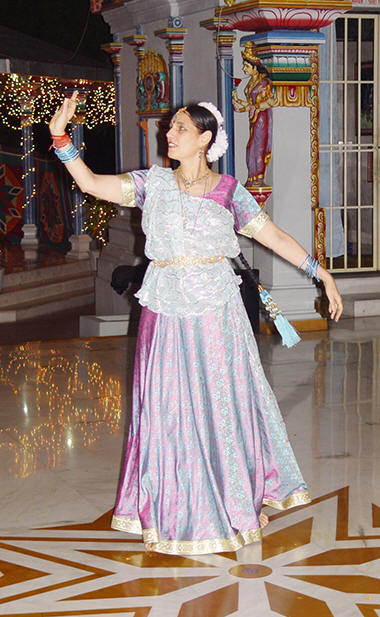 |
Soma in a classical Kathak Dance pose using
the
"Hamsaasya Mudra" with both hands |
Somashekhari while performing dance in Omkarananda-
Kamakshi-Devi Mandir, is showing the "Hamsaasya Mudra"
or "Chin Mudra", depicting infinite Truth, Bliss
and Beauty
(Satyam-Shivam-Sundaram) |
One of the most important Mudras, from the spiritual standpoint,
is the single-hand Mudra "Hamsaasya". The meaning of the Sanskrit
word "Hamsa" is "swan", that beautiful majestic bird, but in the
philosophical context of ancient India "Hamsa" means also the
"Soul". "Aasya" (Sanskrit) means "mouth" or
"face". So the meaning
of this Mudra is "Face (mouth) of the Swan" or
"Face of the Soul".
This Mudra is practically made like this: The tips of the thumb
and the index-finger (fore-finger) of one hand are combined in
such a way, that they form a round shape, a circle. The other
three fingers, middle-finger, ring-finger and small finger are
stretched straight and kept slightly apart from each other.
In
the Indian Classical Dances this Mudra is used with both hands, if
one wants to show the "tying of a necklace", "the flute", "tying
of the marriage-thread", and for "meditation", "divine Wisdom",
and, with the right hand only, for showing "initiation",
"telling,
that something is 'good or certain' ", "drawing" or
"painting", "speaking", "reading", "singing", "the Eternal", "Infinite
Purity", "the Truth", "the Absolute" and with one or both hands to
depict "peacock feathers", "pearls", "gems", "drops of water",
"sounds of the flute", "carrying garlands", "ecstasy" and so many
things more. Very beautiful and delicate, soft things can also be
depicted with this Mudra.
This Mudra is very important because
of its spiritual and mystical implication. It is contributed to
Shri Dakshinamurti, a form of Lord Shiva, who conferred highest
divine Wisdom to his disciples, without uttering any word, using
this Mudra.
Therefore this Mudra is often shown in Indian
Classical Dance for Meditation, divine Wisdom or showing
Enlightenment.
In the field of spirituality this Mudra is
called "Chin*-Mudra". It is the ideal Mudra to concentrate on and
express the Infinite, the Truth, the Absolute, beyond time and
space limitations.
My Sadgurudev H.D. Paramahamsa Omkarananda
Saraswati mentioned in His many speeches the spiritual importance
of this Mudra. This simple gesture can depict the Highest State,
called "Turiya" (the Fourth State) in the Upanishads. The circle,
made by the combination of the thumb and fore-finger, depicts the
Absolute, the undivided One, the Truth, beyond time and space, or
"Turiya", "the Fourth State", consisting of infinite Peace and
Bliss, which is our real Being and which can be experienced
consciously, while living in this mortal body, when we receive the
Grace of the Divine through the Sadguru. The other three fingers
may represent the three gunas in our material time-space-world, or
the three worlds, or the three States (Wakening State, Sleep-State
and Deep-Sleep-State). Swami Omkarananda used to explain to us,
that the circle, or dot, are the most ideal abstract forms to
denote the Infinite, because there is no beginning and no end.
Therefore, if we want to describe the timeless, spaceless,
endless, eternal Being, or Truth, within this limited time-space
world, the symbol of a circle or dot, is most ideal.
According
to ancient Indian Science the thumb represents the individual self
and the fore-finger represents the Guru, the One who removes the
darkness of ignorance from our Soul and leads us to infinite
Happiness, Wisdom and Immortality.
Therefore, if in the
"Chin-Mudra", or "Hamsaasya" Mudra, the fingers, representing the
Guru and the individual self, are combined, it indicates the
Enlightenment and final Liberation of the human being, which is
explained in the Upanishads in different terms, like in one of the
Mahavakyas: "Soham", which means "I am He", i.e.
"I am this
immortal Being", "I am this Infinite Truth".
This Mudra is
used since thousands of years for concentration, meditation and
imparting divine Wisdom.
I personally use this Mudra often,
when I perform Temple-Dances, whenever I want to express infinite
Truth, Divine Wisdom or infinite Divine Beauty. OM
Gurubhakti-Ratna Kumari Somashekhari
-----------------------------------------------------------------------------------------------------------
* "Chin" comes from the Sanskrit word "Chit",
which means in this context "Infinite Consciousness".
Because of a Sanskrit Grammar Rule ("Sandhi") "Chit"
changes to "Chin".
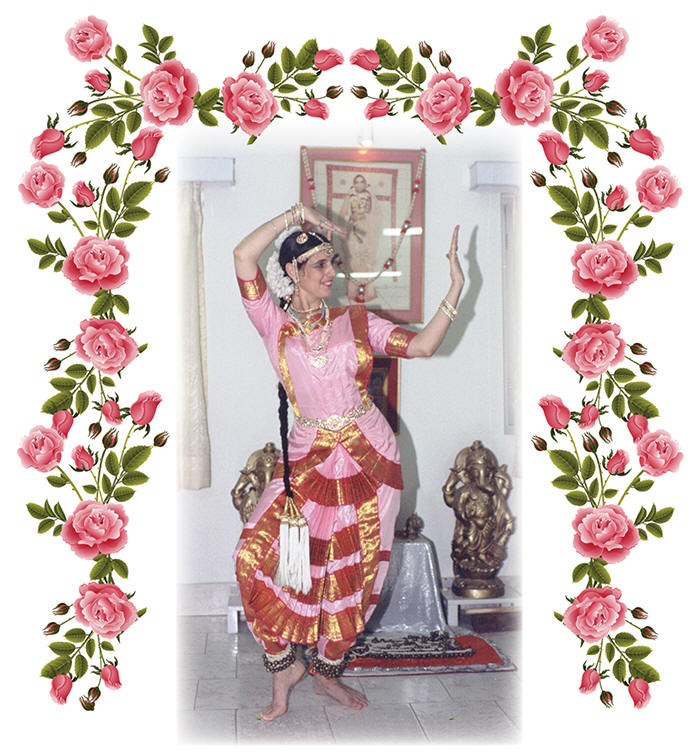 |
Gurubhakti-Ratna Kumari
Somashekhari in front of her Sadgurudev
H.D.
Paramahamsa Omkarananda Saraswati, showing the Mudras
"Pataaka" with
the left hand and
"Tripataaka" with the right hand, which means:
"Seeing oneself in the mirror and applying Tilak."
But the metaphysical meaning of this pose is:
"Seeing oneself as a Reflection of the true Self, the
Absolute Truth, the Sadguru." |
|